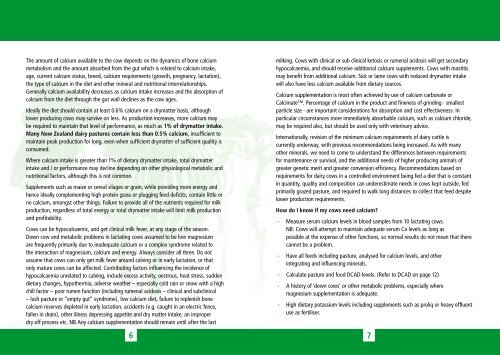CALCIUM & THE DAIRY COW - McDonald's Lime
CALCIUM & THE DAIRY COW - McDonald's Lime
CALCIUM & THE DAIRY COW - McDonald's Lime
Create successful ePaper yourself
Turn your PDF publications into a flip-book with our unique Google optimized e-Paper software.
The amount of calcium available to the cow depends on the dynamics of bone calcium<br />
metabolism and the amount absorbed from the gut which is related to calcium intake,<br />
age, current calcium status, breed, calcium requirements (growth, pregnancy, lactation),<br />
the type of calcium in the diet and other mineral and nutritional interrelationships.<br />
Generally calcium availability decreases as calcium intake increases and the absorption of<br />
calcium from the diet through the gut wall declines as the cow ages.<br />
Ideally the diet should contain at least 0.6% calcium on a drymatter basis, although<br />
lower producing cows may survive on less. As production increases, more calcium may<br />
be required to maintain that level of performance, as much as 1% of drymatter intake.<br />
Many New Zealand dairy pastures contain less than 0.5% calcium, insufficient to<br />
maintain peak production for long, even when sufficient drymatter of sufficient quality is<br />
consumed.<br />
Where calcium intake is greater than 1% of dietary drymatter intake, total drymatter<br />
intake and / or performance may decline depending on other physiological metabolic and<br />
nutritional factors, although this is not common.<br />
Supplements such as maize or cereal silages or grain, while providing more energy and<br />
hence ideally complementing high protein grass or plugging feed deficits, contain little or<br />
no calcium, amongst other things. Failure to provide all of the nutrients required for milk<br />
production, regardless of total energy or total drymatter intake will limit milk production<br />
and profitability.<br />
Cows can be hypocalcaemic, and get clinical milk fever, at any stage of the season.<br />
Down cow and metabolic problems in lactating cows assumed to be low magnesium<br />
are frequently primarily due to inadequate calcium or a complex syndrome related to<br />
the interaction of magnesium, calcium and energy. Always consider all three. Do not<br />
assume that cows can only get milk fever around calving or in early lactation, or that<br />
only mature cows can be affected. Contributing factors influencing the incidence of<br />
hypocalcaemia unrelated to calving, include excess activity, oestrous, heat stress, sudden<br />
dietary changes, hypothermia, adverse weather – especially cold rain or snow with a high<br />
chill factor – poor rumen function (including rumenal acidosis – clinical and subclinical<br />
– lush pasture or “empty gut” syndrome), low calcium diet, failure to replenish bone<br />
calcium reserves depleted in early lactation, accidents (e.g. caught in an electric fence,<br />
fallen in drain), other illness depressing appetite and dry matter intake, an improper<br />
dry off process etc. NB Any calcium supplementation should remain until after the last<br />
6<br />
milking. Cows with clinical or sub clinical ketosis or rumenal acidosis will get secondary<br />
hypocalcaemia, and should receive additional calcium supplements. Cows with mastitis<br />
may benefit from additional calcium. Sick or lame cows with reduced drymatter intake<br />
will also have less calcium available from dietary sources.<br />
Calcium supplementation is most often achieved by use of calcium carbonate or<br />
Calcimate. Percentage of calcium in the product and fineness of grinding - smallest<br />
particle size - are important considerations for absorption and cost effectiveness. In<br />
particular circumstances more immediately absorbable calcium, such as calcium chloride,<br />
may be required also, but should be used only with veterinary advice.<br />
Internationally, revision of the minimum calcium requirements of dairy cattle is<br />
currently underway, with previous recommendations being increased. As with many<br />
other minerals, we need to come to understand the differences between requirements<br />
for maintenance or survival, and the additional needs of higher producing animals of<br />
greater genetic merit and greater conversion efficiency. Recommendations based on<br />
requirements for dairy cows in a controlled environment being fed a diet that is constant<br />
in quantity, quality and composition can underestimate needs in cows kept outside, fed<br />
primarily grazed pasture, and required to walk long distances to collect that feed despite<br />
lower production requirements.<br />
How do I know if my cows need calcium?<br />
- Measure serum calcium levels in blood samples from 10 lactating cows.<br />
NB: Cows will attempt to maintain adequate serum Ca levels as long as<br />
possible at the expense of other functions, so normal results do not mean that there<br />
cannot be a problem.<br />
- Have all feeds including pasture, analysed for calcium levels, and other<br />
integrating and influencing minerals.<br />
- Calculate pasture and food DCAD levels. (Refer to DCAD on page 12)<br />
- A history of ‘down cows’ or other metabolic problems, especially where<br />
magnesium supplementation is adequate.<br />
- High dietary potassium levels including supplements such as proliq or heavy effluent<br />
use as fertiliser.<br />
7


